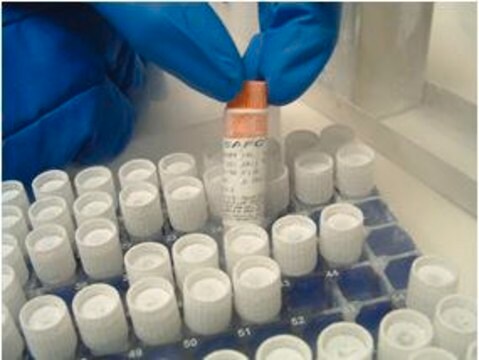おすすめの製品
製品名
MA104, from African green monkey kidney, 85102918, Convention on the International Trade in Endangered Species of Wild Fauna and Flora (CITES)
由来生物
African green monkey kidney
成長モード
Adherent
核型
Not specified
形態
Epithelial
受容体
Not specified
類似した製品をお探しですか? 訪問 製品比較ガイド
細胞株の由来
Monkey African Green kidney
細胞株の説明
Established from an African green monkey foetal kidney. The cells are highly susceptible to Simian rotavirus SA11.
Please note: The species of origin of the MA104 cell line has been shown to be different from that claimed by the originators.
Whitaker & Hayward (1985) found the cell line to originate from an African green monkey and not a Rhesus macaque as was originally claimed. Whitaker AM and Hayward CJ (1985). The characterization of three monkey kidney cell lines. Develop. Biol. Standard. Vol 60: 125-131. PMID: 4043530. Abstract: Three monkey kidney cell lines, Vero, GL-V3 and MA-104 were subjected to karyological analysis to determine their chromosomal stability and to confirm their species of origin. Although the lines were shown to be relatively stable throughout all of the passage levels that were tested, the species of origin of one of them was found to be different from that claimed by the originators. This finding was supported by data from isoenzyme studies.
Please note: The species of origin of the MA104 cell line has been shown to be different from that claimed by the originators.
Whitaker & Hayward (1985) found the cell line to originate from an African green monkey and not a Rhesus macaque as was originally claimed. Whitaker AM and Hayward CJ (1985). The characterization of three monkey kidney cell lines. Develop. Biol. Standard. Vol 60: 125-131. PMID: 4043530. Abstract: Three monkey kidney cell lines, Vero, GL-V3 and MA-104 were subjected to karyological analysis to determine their chromosomal stability and to confirm their species of origin. Although the lines were shown to be relatively stable throughout all of the passage levels that were tested, the species of origin of one of them was found to be different from that claimed by the originators. This finding was supported by data from isoenzyme studies.
培地
継代と培養方法
Split sub-confluent cultures (70-80%) 1:3 to 1:10, i.e., seeding at 1-3x10,000 cells/cm2 using 0.25% trypsin or trypsin/EDTA; 5% CO2; 37 °C.
その他情報
Additional freight & handling charges may be applicable for Asia-Pacific shipments. Please check with your local Customer Service representative for more information.
最新バージョンのいずれかを選択してください:
ライフサイエンス、有機合成、材料科学、クロマトグラフィー、分析など、あらゆる分野の研究に経験のあるメンバーがおります。.
製品に関するお問い合わせはこちら(テクニカルサービス)






